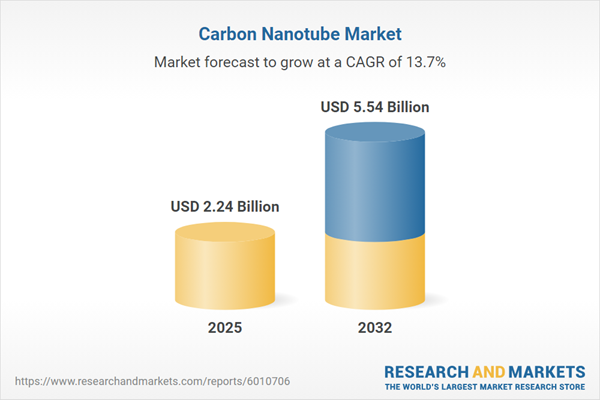Speak directly to the analyst to clarify any post sales queries you may have.
The carbon nanotube market is rapidly evolving, as cutting-edge advancements and strategic collaborations drive adoption across advanced manufacturing, electronics, energy, and healthcare sectors worldwide. This competitive landscape is shaped by technology integration, regulatory dynamics, and global supply chain recalibration.
Market Snapshot: Carbon Nanotube Market Growth and Dynamics
The carbon nanotube market experienced notable growth from USD 1.98 billion in 2024 to USD 2.24 billion in 2025, with ongoing expansion projected at a 13.67% CAGR to reach USD 5.54 billion by 2032. Key sectors—including automotive, electronics, aerospace, energy, and healthcare—are fueling demand for lighter, stronger, and more functional materials. Sector-specific adoption is being influenced by advances in material science, technology transfer, and diversified sourcing models, further amplified by shifting policy environments and industrial digitization.
Scope & Segmentation Across the Carbon Nanotube Market
This report offers a detailed breakdown of the carbon nanotube landscape through the following segments:
- Type: Multi-Walled Carbon Nanotubes, Single-Walled Carbon Nanotubes
- Production Methods: Arc Discharge Method, Chemical Vapor Deposition, High-Pressure Carbon Monoxide Method, Laser Ablation Method
- Application: Aerospace & Defense, Automotive, Electronics & Semiconductor (Field-Effect Transistors, Interconnects & Via Fillers), Energy & Power Generation (Fuel Cells, Solar Cells), Healthcare & Pharmaceuticals (Diagnostics & Imaging, Drug Delivery Systems, Tissue Engineering Scaffolds)
- Regions: Americas (North America: United States, Canada, Mexico; Latin America: Brazil, Argentina, Chile, Colombia, Peru), Europe, Middle East & Africa (Europe: United Kingdom, Germany, France, Russia, Italy, Spain, Netherlands, Sweden, Poland, Switzerland; Middle East: United Arab Emirates, Saudi Arabia, Qatar, Turkey, Israel; Africa: South Africa, Nigeria, Egypt, Kenya), Asia-Pacific (China, India, Japan, Australia, South Korea, Indonesia, Thailand, Malaysia, Singapore, Taiwan)
- Key Companies: Alfa Chemistry, Arkema S.A., Beijing Dk Nano Technology Co., Ltd., Cabot Corporation, Carbon Solutions, Inc., CHASM Advanced Materials, Inc., Cheap Tubes, Inc., Dazhan Nanomaterials Co., Ltd., Jiangsu Cnano Technology Limited, Klean Industries Inc., LG Chem Ltd, NanoIntegris Inc., Nanolab Inc., Nanoshel LLC, OCSiAl, Raymor Industries Inc., Resonac Holdings Corporation, Sumitomo Electric Industries, Ltd., Thomas Swan & Co. Ltd., CD Bioparticles, Huntsman Corporation, Denso Corporation, Canatu Oy
Key Takeaways for Senior Decision-Makers
- Breakthroughs in synthesis and functionalization are redefining how producers approach high-purity, application-tailored carbon nanotube solutions.
- Upgraded reactor designs and innovative catalyst engineering are enhancing production throughput while improving uniformity and scalability for both single- and multi-walled configurations.
- Advanced dispersion and alignment techniques enable consistent integration of nanotubes into composites, resulting in materials with enhanced performance for demanding industrial applications.
- Strategic partnerships among manufacturers, OEMs, and research institutions accelerate end-to-end value delivery and cut development times for new product launches.
- Active participation in consortia and industry standardization efforts reinforces interoperability and competitive positioning for companies seeking cross-sector contracts.
Tariff Impact: Navigating Supply Chain Disruption and Resilience
The imposition of increased tariffs in the United States has resulted in a fundamental shift in supply chain and sourcing strategies for carbon nanotube producers and downstream users. Changes in tariff levels have prompted organizations to diversify sourcing, strengthen domestic partnerships, and invest in local processing capabilities, enhancing resilience against regulatory fluctuations and trade realignment. Procurement teams are responding with tighter inventory controls and broadened supplier networks to mitigate risk.
Methodology & Data Sources
Analysis draws on a combination of primary interviews with technology providers, equipment suppliers, end-user integrators, and regulatory experts. This foundation is supported by comprehensive secondary research, including patent records, academic literature, industry reports, and policy analyses. Triangulation methods were used to cross-verify emerging trends and validate insights across sources.
Why This Report Matters: Strategic Guidance for Carbon Nanotube Stakeholders
- Enables data-driven investment, technology selection, and partnership decisions across segments and regions.
- Equips leaders with scenario planning frameworks to anticipate tariff impacts and supply chain risks.
- Supports benchmarking against industry innovators, standardization activities, and regulatory best practices to maintain a competitive edge.
Conclusion
The carbon nanotube market is poised for sustained expansion driven by technological advancement and strategic alignment. Senior leaders equipped with robust market insights and adaptive strategies are best positioned to unlock new opportunities and lead in this dynamic sector.
Additional Product Information:
- Purchase of this report includes 1 year online access with quarterly updates.
- This report can be updated on request. Please contact our Customer Experience team using the Ask a Question widget on our website.
Table of Contents
3. Executive Summary
4. Market Overview
7. Cumulative Impact of Artificial Intelligence 2025
Companies Mentioned
The companies profiled in this Carbon Nanotube market report include:- Alfa Chemistry
- Arkema S.A.
- Beijing Dk Nano Technology Co., Ltd.
- Cabot Corporation
- Carbon Solutions, Inc.
- CHASM Advanced Materials, Inc.
- Cheap Tubes, Inc.
- Dazhan Nanomaterials Co., Ltd
- Jiangsu Cnano Technology Limited
- Klean Industries Inc.
- LG Chem Ltd
- NanoIntegris Inc.
- Nanolab Inc.
- Nanoshel LLC
- OCSiAl
- Raymor Industries Inc.
- Resonac Holdings Corporation
- Sumitomo Electric Industries, Ltd.
- Thomas Swan & Co. Ltd.
- CD Bioparticles
- Huntsman Corporation
- Denso Corporation
- Canatu Oy
Table Information
| Report Attribute | Details |
|---|---|
| No. of Pages | 183 |
| Published | November 2025 |
| Forecast Period | 2025 - 2032 |
| Estimated Market Value ( USD | $ 2.24 Billion |
| Forecasted Market Value ( USD | $ 5.54 Billion |
| Compound Annual Growth Rate | 13.6% |
| Regions Covered | Global |
| No. of Companies Mentioned | 24 |









